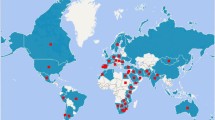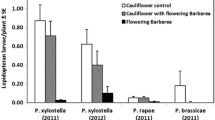Abstract
Chromolaena odorata L. is a major weed of tropical plantations and pasture lands.Pareuchaetes pseudoinsulata Rego Barros [Lep.: Arctiidae] was mass-reared and released to control the weed on the Mariana Islands of Guam, Rota, Tinian and Saipan in the western Pacific. One year following establishment ofP. pseudoinsulata on Guam, the weed was reduced 100% at 3 of 4 sites monitored with fixed quadrats. Seed production was prevented if defoliation occurred prior to the beginning of the flowering season. If defoliation occurred shortly after flowering began, the developing seeds were eaten byP. pseudoinsulata or there was a significant reduction in weight and germination of seeds that matured. Eighteen months after establishing on Guam,P. pseudoinsulata had defoliated approximately 25,000 hectares of the weed. This is the 1st report on the quantitative impact of any control agent forC. odorata, and though the long term effect of the insect is still unknown, these results are encouraging.
Résumé
Chromolaena odorata L. est une mauvaise herbe qui prédomine dans les cultures et les pâturages tropicaux.Pareuchaetes pseudoinsulata Rego Barros [Lepidoptera: Arctiidae] fut élevé en masse et introduit dans les Iles Mariannes du Pacifique Occidental, en l'occurrence Guam, Rota, Tinian, et Saipan, dans le but de lutter contre cette mauvaise herbe. Dans l'année qui suivit l'introduction deP. pseudoinsulata dans l'Ile de Guam, cette mauvaise herbe fut réduite de 100% dans 3 sites sur quatre, contrôlés au moyen de quadrats fixés. La défoliation de cette herbe antérieure à sa floraison, empêche la montée en graine. Dans le cas d'une défoliation amorcée immédiatement après le début de la floraison, on constatait que les graines en développement furent consommées parP. pseudoinsulata ou, le cas échéant, que le poids ainsi que le taux de germination des graines mûres furent sérieusement réduits. Dix-huit mois après son introduction dans l'Ile de Guam, le lépidoptère avait réussi à défeuiller près de 25000 hectares. Ceci constitue le premier rapport sur l'effet quantitatif d'un agent régulateur quelconque surC. adorata et, bien que nous ignorions encore les effets à long terme de cet insecte, ces premiers résultats sont encourageants.
Similar content being viewed by others
References
Bennett, F. D. &Crutwell, R. E. — 1973. Insects attackingEupatorium odoratum in the neotropics. 1.Ammalo insulata (Walk.) [Lep.: Arctiidae], a potential biotic agent for the control ofEupatorium odoratum L. [Compositae]. —Commonw. Inst. Biol. Control, Tech. Bull., 16, 105–115.
Bennett, F. D. &Rao, V. P. — 1968. Distribution of an introduced weedEupatorium odoratum Linn. [Compositae] in Asia and Africa and possibilities of its biological control. —PANS(c), 14, 277–281.
Cock, M. J. W. &Holloway, J. D. — 1982. The history of, and prospects for, the biological control ofChromolaena odorata [Compositae] byPareuchaetes pseudoinsulata Rego Barros and allies [Lepidoptera: Arctiidae]. —Bull. Entomol. Res., 72, 193–205.
Cruttwell, R. E. — 1972a. The insects ofEupatorium odoratum L. in Trinidad and their potential as agents for biological control. —Ph. D. Thesis, University of the West Indies, 241 pp.
Cruttwell, R. E. — 1972b. Memorandum on the selection of stocks ofAmmalo insulata for release againstEupatorium odoratum. —Commonw. Inst. Biol. Control, Commonw. Agric. Bureaux, Farnham Royal Slough, UK, 3 pp.
Cruttwell, R. E. — 1973. Insects attackingEupatorium odoratum in the neotropics. 2. Studies of the seed weevilApion brunneonigrum B.B., and its potential use to controlEupatorium odoratum L. —Commonw. Inst. Biol. Control, Tech. Bull. 16, 117–124.
Cruttwell, R. E. — 1977a. Insects and mites attackingEupatorium odoratum L. in the neotropics. 6. Two eriophyid mites,Acalitus adoratus Keifer andPhyllocoptes cruttwellae Keifer. —Commonw. Inst. Biol. Control, Tech. Bull., 18, 59–63.
Cruttwell, R. E. — 1977b. Insects and mites attackingEupatorium odoratum L. in the neotropics. 5.Mescinia sp. nr.parvula (Zeller). —Commonw. Inst. Biol. Control, Tech. Bull., 18, 49–58.
Dharmadhikari, P. R., Perera, P. A. C. R. &Hassen, T. M. F. — 1977. The introduction ofAmmalo insulata for the control ofEupatorium odoratum in Sri Lanka. —Commonw. Inst. Biol. Control, Tech. Bull., 18, 129–135.
Holm, L. G., Plucknett, D. L., Pancho, J. V. &Herbergh, P. D. — 1977. The World's Worst Weeds, Distribution and Biology. —Univ. of Hawaii Press, Honolulu, 609 pp.
Julien, M. H. — 1987. Biological Control of Weeds: A World Catalogue of Agents and their Target Weeds, 2nd Edition. —Commonw. Agric. Bur. Int., Wallingford, 114 pp.
Macdonald, I. A. — 1983. Alien trees, shrubs and creepers invading indigenous vegetation in the Hluhluwe-Umfolozi Game Reserve Complex in Natal. —Bothalia, 14, 949–959.
Pancho, J. &Plucknett, D. — 1971.Chromolaena odorata (L.) R. M. King and H. Robinson a new record of a noxious weed in the Philippines. —J. Ani. Sci., 8, 143–149.
Soerohaldoko, S. — 1971. On the occurrence ofEupatorium odoratum at the game reserve Penanjung, West Java, Indonesia. —Weeds of Indonesia, 2, 9.
Swezey, O. H. (ed). — 1942. Insects of Guam. I. —Bernice P. Bishop Museum Bull., 172, 218 pp.
Swezey, O. H. (ed.) — 1946. Insects of Guam. II. —Bernice P. Bishop Museum Bull., 189, 237 pp.
Author information
Authors and Affiliations
Rights and permissions
About this article
Cite this article
Seibert, T.F. Biological control of the weed,Chromolaena odorata [Asteraceae], byPareuchaetes pseudoinsulata [Lep.: Arctiidae] on Guam and the northern Mariana Islands. Entomophaga 34, 531–539 (1989). https://doi.org/10.1007/BF02374391
Received:
Accepted:
Issue Date:
DOI: https://doi.org/10.1007/BF02374391




